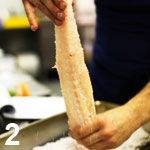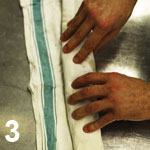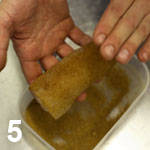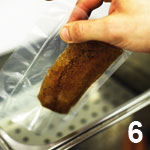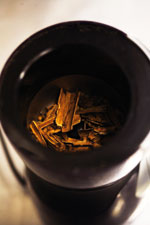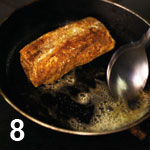Glynn Purnell masterclass – Monkfish
Many chefs use water bath cooking because it allows control and consistency, and packs in flavour. Michael Raffael explains how to cook Glynn Purnell's monkfish masala, which uses this technique to retain moisture and soak up the full flavour of the spices
Sous-vide, the technique of cooking ingredients in a vacuum-sealed plastic bag in a water bath, usually for a long time at a low temperature, was developed over 30 years ago. It gained a toehold in the kitchen because it was an ideal cook-chill solution for fine-dining restaurants.
Three-star chefs such as Claude and Michel Troisgros and the Roux brothers adopted it. The quality, they said, was as good as that of classically prepared dishes. Current chefs use the technique because, they claim, it allows exact control, guarantees consistency and packs in flavour.
Cooking joints for up to 72 hours this way has soaked up the headlines. Advantages in succulence and tenderness are self-evident. Slow-cooking individual portions of prime meat, before finishing it on the grill or in the pan, makes sense, too.
Vacuum-packed know-how hasn't really been applied to fish. In part, this is because most seafood cooks quickly anyway. Also, searing a boneless slab of fish in a Teflon pan has been the preferred way for over a decade. However, the herbs, flavourings and seasonings in vacuum packs can transfer their flavour to the protein in the fish much better than with conventional recipes.
Glynn Purnell's monkfish masala ticks the correct sous-vide boxes. The firm-textured, meaty fish can easily be overcooked or undercooked in a pan. The 62°C water bath ensures that it's moist but cooked right through every time. It doesn't need probing or resting. The flavour of the spice dusting on the surface permeates the flesh; it sets on the surface and coats the fish evenly.
Is water bath fish cookery the ideal solution for busy kitchens? It's certainly another weapon in the armoury, and works when it's managed by chefs who know exactly how to apply it. The raw material, especially, has to be pristine. Glynn Purnell salts the monkfish to extract some moisture and to firm up the texture before packing it.
What works for monkfish would probably be wasted on softer or smaller fillets. However, the technique could transform a thick-cut steak of halibut, cod or turbot or even conger eel, provided the bones were all removed.
Photos by Lisa Barber (www.lisabarber.co.uk)
Monkfish masala poached in a water bath
Planning
Day 1
Salt the monkfish tail and rest overnight.
Day 2
Prepare a fresh spice mix; portion, spice and poach the fish in individual vacuum pouches.
Ingredients
Serves six to eight)
500g coarse salt
2 x 450-500g trimmed monkfish tail
1-2tbs spice mix per tail
Method
Put the salt in a box, container or on a tray. Roll each tail in the salt so it's encrusted on the surface. Refrigerate for six minutes (use a timer) (1)
Take the tail and rub off the salt by hand, then run the tail under a cold tap and dry it (2).
Wrap the fillet in a clean tea towel or similar cloth, and refrigerate overnight (3). This gives a firm well-flavoured fillet that doesn't require any more seasoning with salt. Although this isn't a curing technique, fish prepared this way can be kept refrigerated for three to four days without significant loss of quality, provided that it was in prime condition on delivery.
Unwrap the fillet. If there are any dark patches (blood lines) on its surface give them a final trim. Divide the tail into three to four portions, five if the fish is for a tasting menu (4).
Roll each portion in the spice mixture along its length only, so it looks like a log with white ends (5). Pat the spice against the fish so it sticks to it.
Put each portion in a sous-vide pouch and vacuum-pack it.
If you are poaching several portions of fish at one go, set the water bath to 63°C. If you are only cooking one portion set it at 62°C (6 and 7) .
Poach the fish for 10 to 12 minutes, according to its thickness.
Ingredients and method
(Provides 6-10 portions)
15cm stick of cinnamon, broken up
4tsp fenugreek seeds
1tsp fennel seeds
3tsp cumin seeds
2tsp coriander seeds
3tsp black mustard seeds
10 cloves
Grind to a fine powder in an electric spice mill.
Monkfish masala with indian lentils, coconut and pickled carrots
Ingredients (Serves one)
1 poached monkfish tail portion
10ml sunflower oil
10g butter
40g Indian lentils
2tbs reduced coconut cream
20g pickled carrots
4-5 shards of toasted coconut
1tsp curry oil (infuse mild curry powder in a neutral oil)
Coriander shoots
Method
Take the hot, poached tail out of its sous-vide pouch. Heat the oil in a small frying pan until it smokes. Drain off the oil from the pan.
Return to the heat and add the butter, which will sizzle on contact. Sear the monkfish tail in the butter for about two minutes, turning it so all the spice is in contact with the fat (8).
Take off the heat and slice into two "tournedos".
Spoon a small mound of Indian lentils on the plate. Lay one piece of monkfish on it and another beside it.
Spoon coconut cream on to the plate. Arrange pickled carrot julienne over each fillet, topped with coconut shards. Drip a little curry oil on to the coconut cream and sprinkle coriander shoots on the plate for colour.
ACCOMPANIMENTS
Make this preserve about two weeks in advance to let it mature
Ingredients
500g large carrots
3tsp fenugreek seeds
1tsp ajwain seeds
1tsp mustard seeds
1/2tsp onion seeds
1tsp cumin seeds
1/3tsp chilli flakes
1tsp salt
Method
Peel and julienne the carrots. Put them on a tray and dry them out during service on top of the stove. Transfer them to a Kilner jar or similar, and add the spices.
Cover the carrots with oil. Seal the lid and set aside, preferably out of the light.
Indian lentils
This is a toned-down version of a dhal. Make the first stage in advance.
Ingredients and method
Sweat 60g of diced onion in a 1tbs of sunflower oil or ghee. Add 1tbs of mild curry or korma powder and heat until fragrant. Add 200g of red lentils and stir. Cover with chicken stock, up to 400ml. Bring to the boil, then simmer until tender, which takes about 20 minutes. Check seasoning.
To serve
Reheat about 100g of cooked dhal at a time and stir in 1tsp of fresh coriander leaves and a small pinch of finely diced red chilli, just before plating up.
The dhal should be firm enough to hold its shape on the plate.
Reduced coconut cream
Reduce 250ml coconut cream by a third. Season with a sprig of fresh coriander, a squeeze of lime juice and fleur de sel.
Toasted coconut
Slice some fresh coconut as finely as possible on a mandolin or microplane grater. Roast in a slow oven until pale brown, taking care not to burn it.
Filleting and trimming monkfish tails
It's easy to detect freshness in monkfish tails because the blood is bright red and there are no off odours.
â- The supplier may already have removed the monkfish skin. If he hasn't, lay the tail with its rounded surface up and lift an edge of the slippery skin above the backbone. Cut between it and the sinew over the tail meat. Pull off the skin to expose the tapering tail.
â- The white meat is covered with a thick, muscular membrane. Put the knife under the loose flap of flank and start loosening the membrane coat from the tail meat. Work one side of the bone then the other. Start with a knife but you can ease your fingers between the flesh and the membrane.
â- Using the cartilaginous backbone as a guide, cut a line down the length of the tail. Keeping the knife tight against the cartilage, ease away one side of the tail. Take off the second side.
The landing price of whole monkfish varies, catch by catch, from £2 to £6 per kg, depending on size, grade, freshness and availability.
â- Head-to-tail ratio is about 3.25:1.75. This translates to 6.5kg of disposable head to 3.5kg of pre-trim tail.
â- A 2kg monkfish tail will yield two fillets weighing 450-500g each, depending on trimming.
â- The trimmed weight of tail as a percentage is 45% to 50%.
For practical portioning, it's easier to work with fillets in the above weight bracket. Small monkfish tails may weigh as little as 150g. The odd giant fish has a tail weighing 10kg or more, but this tends to be coarse and chewy.
Fusion is a two-way street: some of the best Asian menus reflect skills borrowed from the European repertoire. Pacific Rim chefs have adapted Chinese and south-east Asian ingredients and techniques. British chefs have been slow to learn from the thousands of sub-continent restaurants in the UK, but Glynn Purnell, chef-proprietor of Purnell's restaurant in Birmingham, bucks the trend.
He has the curiosity allied to the confidence in his palate to recreate the spice blends of Birmingham's Balti shops and apply them to his own inventive style of cookery.
His fish course impressed judges Prue Leith, Oliver Peyton and Matthew Fort on the Great British Menu - favoured as one of the courses cooked for British troops returning from Afghanistan at a gala dinner in June. The other seven finalists were Tristan Welch, head chef at Launceston Place in London, Shaun Rankin, head chef at Bohemia Bar & Restaurant at the Club Hotel & Spa in Jersey, Kenny Atkinson, head chef at Seaham Hall in Seaham, Northumbria, Tom Kitchin, chef-proprietor of the Kitchin in Leith, Edinburgh, and Danny Millar, chef-proprietor of Balloo House in Killinchy, Northern Ireland.
Photos by Lisa Barber (www.lisabarber.co.uk)




